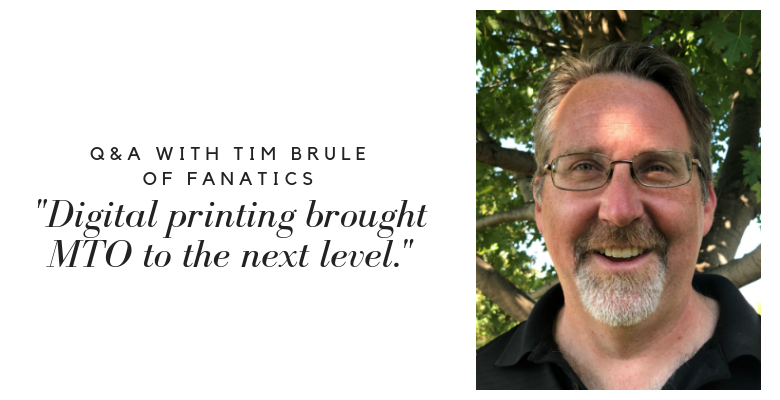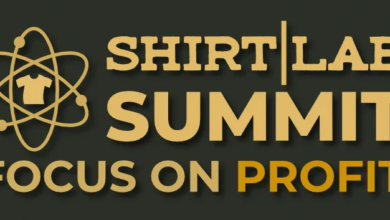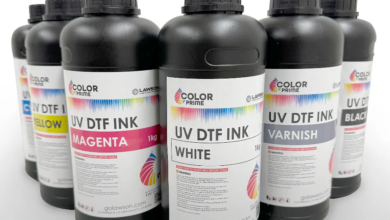Q&A with Tim Brule of Fanatics
Tim Brule, Fanatics, talks about MTO opportunities and his role in Fanatics success.

Q: Tell me a little bit about your time at Fanatics. When did you start? What is your role as VP of Disruptive Technologies?
A: I started working for Fanatics in 2009. I was brought in to start their made to order (MTO) manufacturing division. They purchased a software and consulting firm called DemandMade Inc. from me and my partner. DemandMade was designed to make one of something. It was based on generating Dynamic Virtual Skus by setting up metadata about the product. The sku is reusable in case of a return. It helps manage manufacturing workflows on the floor by using a state control system and interfacing with manufacturing equipment like laser cutters and DTG machines.
My roles have changed over time, but I have always been heavily involved in MTO and its technologies. My current boss changed my title to disruptive technology about six months ago from manufacturing innovations.
Q: When you came into this role, where was Fanatics at in the digital printing process at that time?
A: Fanatics did not manufacture anything at all. I brought in digital printing, heat press, cad cutting, and embroidery in 2009.
Q: How has the company grown in its digital printing capabilities since then?
A: We have seen explosive growth in manufacturing. We are on pace for three million digital impressions in 2018. I hope to grow that by 100 percent in 2019.
Q: What were your strategies for bringing digital printing capabilities to Fanatics? What did that progress look like for a company that didn’t have any of those capabilities?
A: I was brought in in 2009 to start manufacturing. I sold a software solution to them and integrated with their systems in four months. We went with DTG made, heat pressing, appliqué day one. The first peak was tough. We went from no orders to 2,500 units a day. I was in charge of forecasting, operations, and technology. All of our processes were designed to be trained easily so we can ramp staffing with temporary employees. If you were designing workflows for stable sales curves, you would not have as many touches as we do, collapsing multiple steps into one. But being dependent on temps stirred the direction of our processes to have simple steps with high units per hour (UPH).
Q: Fanatics can be looked at as a great success story when it comes to large-volume direct-to-garment printing. For Fanatics, what is that success attributed to?
A: MTO technology allows you to create virtual inventory. You can stay in stock with hot-selling items deeper into peak selling seasons. Even the most basic distressed primary logo T-shirts are tough to keep in stock when a team gets hot during the holidays. We were able to keep product up for the entire selling season for teams like the Philadelphia Eagles and New England Patriots. All we needed was the blank silhouette in stock, and we could decorate it made to order.
Q: Have “peak selling seasons” and “personalized product” always been huge sells for Fanatics?
A: Team licensed product is a very popular gift item. For example, we offered personalized product for major hot market events like the World Series, Stanley Cup, and Super Bowl. We sold a large number of personalized T-shirts for the Washington Capitals with the Stanley Cup logo on them. You simply cannot react fast enough without MTO. If you try, you end up with too much of the wrong inventory. We have always had huge differences between peak and values. We still see a 20 to 1 difference between our smallest and largest weeks. Before 2009 we offered personalized jerseys. By introducing MTO in 2009, we expanded to apparel.
Q: And what was it about MTO technology that piqued your interest in the beginning?
A: ?I started doing MTO well before digital printing existed. In 1996, I co-owned a company private labeling sports e-commerce sites for sports and media partners called FanBuzz Inc; Fanatics starting in that space after FanBuzz. We were looking for ways to expand assortment and reduce inventory at the same time. MTO solves both freeing up cash and generating more sales-reduces aged obsolete inventory. Digital printing brought MTO to the next level.
For more information on Fanatics, visit www.fanatics.com.




